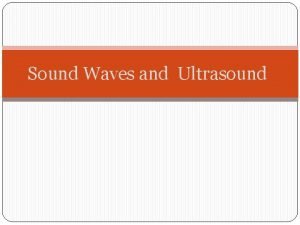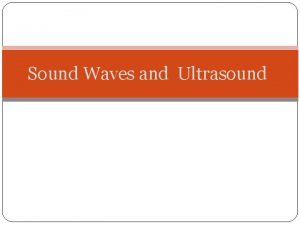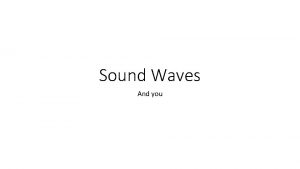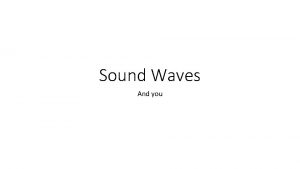Week 3 Sound Waves Sound Waves Sound comes








- Slides: 8

Week 3 Sound Waves

Sound Waves ● Sound comes from vibrations ● Sound moves faster in water ● We use our ears to hear vibrations which turns into sounds

Sound Waves ● Sound waves differ from each other ● Sound waves can be helpful to us ● Sound may also hurt our ears

Sound waves differ from each other by: ● Pitch - How long or how high you perceive a sound to be ● Loudness - How loud or soft a sound is perceived to be ● Echo - A reflected sound wave

Sound Waves can be helpful to us. ● Sound waves allows us to communicate with one another. ● Can allow us to find objects through Echolocation - the process of using reflected sound waves to find objects. ● Sound can warn us about things that are about to occur. ● Ex. Thunder signaling a storm is near.

Sound may also hurt our ears. ● When sound is too loud and hurts our eardrums, we may result in loss of hearing and may possibly become deaf. ● An example may be from experiencing a Sonic Boom - the explosive sound heard when a shock wave reaches your ears. ● Today in many cities people experience noise pollution. Noise pollution is unwanted or disturbing sound.

How do we perceive sound waves ● Sound waves travel through the ear by the ear canal(3) to the eardrum(4). The sound waves then travel to the cochlea (7) which is filled with tiny hair cells. These hair cells detect the sound waves and process them as electrical signals to the brain by the hearing nerve (9). The brain then allows us to know what the sound is.

How Do Bats Fly In the Dark ● Bats use a method called echolocation ● Echolocation is when the bats emit a high frequency sound that bounces off cavern walls and rebounds back into their ears so they can locate where obstacles exist ● They also use this method for hunting
 Sound comes in waves
Sound comes in waves Longitudinal wave vs transverse wave
Longitudinal wave vs transverse wave Differences between mechanical and electromagnetic waves
Differences between mechanical and electromagnetic waves The wave chapter 13
The wave chapter 13 Is echolocation transverse or longitudinal
Is echolocation transverse or longitudinal First comes love, then comes marriage
First comes love, then comes marriage Week by week plans for documenting children's development
Week by week plans for documenting children's development Mechanical waves characteristics
Mechanical waves characteristics Similarities of mechanical and electromagnetic waves
Similarities of mechanical and electromagnetic waves















